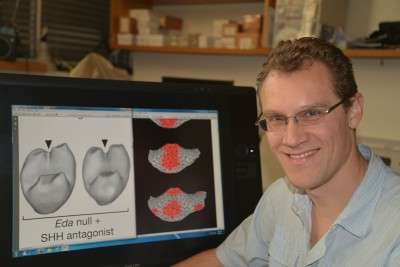How teeth explain the tree of life

Clues contained in mice teeth have allowed scientists to reconstruct evolutionary history in the laboratory.
The study, published today in the journal Nature, reveals how researchers fine-tuned the shape of a mouse tooth to produce the gradual transitions observed in the fossil record.
In the past, biologists studied animals with gene mutations to discover how the small details of teeth can help them understand the evolutionary relationships of extinct species. However, the changes were often too dramatic to be very informative.
In contrast, the international collaboration involving a Monash University researcher used laboratory experiments on developing teeth. Combined with computer simulations, the research shows for the first time how the processes of development influence the evolution of fine tooth features.
The findings could make it much easier to reconstruct the evolutionary history of mammals from fossils.
One of the lead researchers, Dr Alistair Evans, from the School of Biological Sciences at Monash University said teeth held many clues about the evolution of animals.
"If you want to reconstruct the tree of life of extinct animals, teeth are often the best or only evidence that paleontologists have available. Particularly for mammals, the fine features of teeth help us to determine how fossil species are related to each other and modern animals," he said.
"However, we have always been limited in what we can learn because many features of teeth are correlated when the embryo develops so they evolve together. Here we have been able to show how some of these correlations work," said Dr Evans.
The research team retraced the evolutionary steps of teeth by applying the protein of a mutant gene to the molars of mutant mice in the laboratory, which are simple cone-shaped cusps. The protein was added in small, incremental steps to see if all features of the teeth change at the same time.
The experiments revealed how cusps, the main features of teeth, reappeared with increasing amounts of protein, and in much the same order that cusps have evolved in early mammal molars. In another experiment adding a second protein, teeth could be produced that look remarkably like those in the ancestors of rodents, as seen in fossils.
"We now have clues to which genes and factors in development were altered to change from early rodents to modern mice."
Dr Evans said the evolution of rodents shown in the experiment also applies to carnivorous animals too. He examined how tooth complexity changed in these mammal groups.
"Amazingly, we found that the features that we could control in mice vary in the same way in carnivorous mammals like the lion, wolf, and bear - the same rules apply to cats and mice," said Dr Evans.
The next phase of research will investigate other mechanisms that influence tooth development, and apply these results to more accurately reconstruct the history of mammals.
Journal information: Nature
Provided by Monash University


















